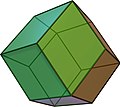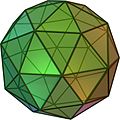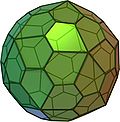Top Qs
Timeline
Chat
Perspective
Catalan solid
13 polyhedra; duals of the Archimedean solids From Wikipedia, the free encyclopedia
Remove ads
The Catalan solids are the dual polyhedra of Archimedean solids. The Archimedean solids are thirteen highly-symmetric polyhedra with regular faces and symmetric vertices.[1] The faces of the Catalan solids correspond by duality to the vertices of Archimedean solids, and vice versa.[2]

The solids
Summarize
Perspective
The Catalan solids are face-transitive or isohedral meaning that their faces are symmetric to one another, but they are not vertex-transitive because their vertices are not symmetric. Their dual, the Archimedean solids, are vertex-transitive but not face-transitive. Each Catalan solid has constant dihedral angles, meaning the angle between any two adjacent faces is the same.[1] Additionally, two Catalan solids, the rhombic dodecahedron and rhombic triacontahedron, are edge-transitive, meaning their edges are symmetric to each other.[citation needed] Some Catalan solids were discovered by Johannes Kepler during his study of zonohedra, and Eugene Catalan completed the list of the thirteen solids in 1865.[3]

In general, each face of a dual uniform polyhedron (including the Catalan solid) can be constructed by using the Dorman Luke construction.[4] Some of the Catalan solids can be constructed, starting from the set of Platonic solids, all faces of which are attached by pyramids. These examples are the Kleetope of Platonic solids: triakis tetrahedron, tetrakis hexahedron, triakis octahedron, triakis icosahedron, and pentakis dodecahedron.[5]
Two Catalan solids, the pentagonal icositetrahedron and the pentagonal hexecontahedron, are chiral, meaning that these two solids are not their own mirror images. They are dual to the snub cube and snub dodecahedron respectively, which are also chiral.
Eleven of the thirteen Catalan solids are known to have the Rupert property that a copy of the same solid can be passed through a hole in the solid.[6]
Remove ads
References
External links
Wikiwand - on
Seamless Wikipedia browsing. On steroids.
Remove ads













